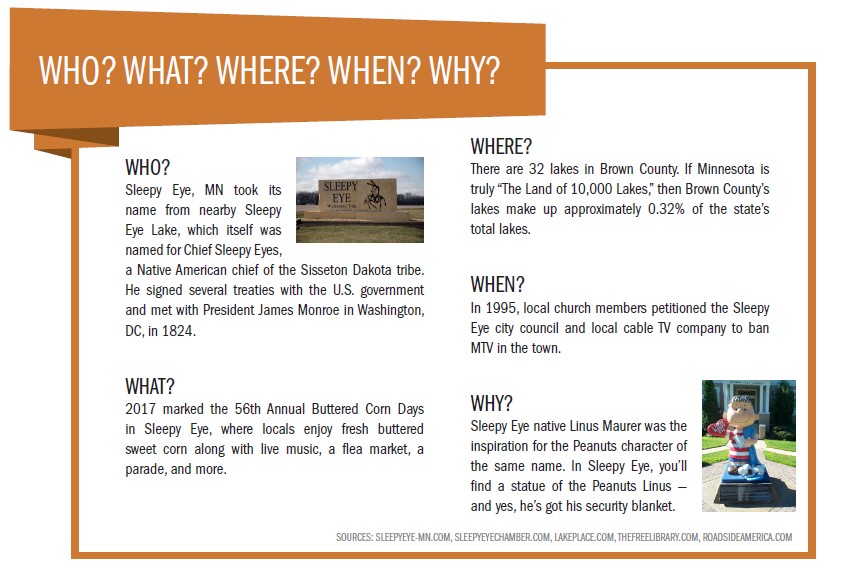CU QUICK FACTS
SouthPoint Financial Credit Union
Data as of 09.30.17
HQ: Sleepy Eye, MN
ASSETS: $326.1M
MEMBERS: 17,734
BRANCHES: 6
12-MO SHARE GROWTH: 9.1%
12-MO LOAN GROWTH: 15.5%
ROA: 0.41%
Sleepy Eye, MN, is a town of less than 3,500 people located in Brown County, approximately 100 miles southwest of the Twin Cities of Minneapolis and St. Paul. The population of both Sleepy Eye and Brown County has declined over the past several decades more than 12% for the county, according to the latest census data. This fact, coupled with the area’s low unemployment rate, makes it difficult for a financial institution to serve the area.
Without new business, FIs have a tough time achieving meaningful scale; and without scale, long-term sustainability is called into question.
But in 2015, SouthPoint Financial Credit Union ($326.1M, Sleepy Eye, MN), a local credit union that runs on thin margins, wasn’t ready to give up on its community. SouthPoint was ready to take action. So, the cooperative decided to liven up its prospects a decision with which many a sleepy credit union across the country might relate.
We get busy living, or we get busy dying, says credit union CEO Dick Nesvold.
For SouthPoint’s vice president of retail services, Jay Gostonczik, living means building relevance and sustainability. That’s how financial institutions make it in tight markets. Whether the market is tight because of decreasing population or increasing expectations is irrelevant.
Survivors adapt their business model and add value to their memberships, Gostonczik says.
To add value to its membership, SouthPoint meets members where they are, either physically or financially, because that’s the right thing to do for member-owners. It really is that simple for the leaders at this North Star State credit union.
If we do the right things for the right reasons, everything will take care of itself, Nesvold says.
We need to provide the convenience and services that any bank offers. Everyone sees those and wants them.
Branching And Beyond (Meeting Members Where They Are: Part 1)
SouthPoint was founded in 1936 to serve Catholic parishes in Brown County. In 2001, the credit union converted to a federal charter and extended its field of membership into Redwood and Renville counties. By the mid-aughts, SouthPoint had opened two additional branches, one in Springfield and one in New Ulm.
South-central Minnesota is rural, with an economy based on agriculture and manufacturing. Unfortunately for SouthPoint, its branch locations were planted in towns with negative population growth. Sleepy Eye has lost 7% of its population from its high mark in 1990. New Ulm has lost 3% since 1980. And in Springfield, the population has declined by 24% since 1960.
For the credit union to survive, it needed new members that it wasn’t finding in its field of membership.
We were looking for growth but couldn’t find it within our population, Nesvold says. We had to go out and steal it.
In 2015, the credit union converted its charter again, from federal back to state. It also added to its field of membership 10 counties in southcentral Minnesota including Carver and Blue Earth, both within the top 15 largest counties in the state.
Today, the credit union’s potential membership exceeds 450,000, says Troy Diedrich, vice president of marketing and development for SouthPoint.

The credit union served more than 7% of its potential membership base prior to the expansion. For comparison, the average reach for credit unions with $250 million to $500 million in assets is not quite 4%. The expansion brought SouthPoint’s average down to approximately 3.8%, which is back in line with its peers.
To accommodate its larger membership base, the credit union also expanded its branch footprint. SouthPoint opened an 850-square-foot microbranch in St. Peter, MN, population 11,692, in 2015. It opened two more full-line branches in 2017. One in North Mankato population 13,619 and one in Hutchinson population 13,888. Crucially, population in these three towns has spiked since the year 2000.
But SouthPoint isn’t just adding square footage.
Members old and new know this cooperative based in a sleepy town is anything but. The credit union has a modern retail strategy that plays up technology as well as personal touchpoints. It has invested in its website and mobile app while at the same time transitioning branches to consultative hubs.
SouthPoint also has updated its approach to branch staffing. In its re-imagined branch manager role, branch presidents focus on community development and outreach. Head tellers, meanwhile, take the lead in branch service. The credit union also trains all branch staff as universal bankers who can provide a variety of services at a branch’s open-area work station.
Big changes, to be sure, but this is the future of financial services, says Gostonczik.
It was quite a process, but we needed to adapt to advances in technology and changes in consumer behavior, he says.
We’re a $330 million institution housed in a town of 3,000. We must look at new opportunities and initiatives and take risks.
Finding A Financial Footing (Meeting Members Where They Are: Part 2)
For the past seven months, SouthPoint has worked with its core processor to integrate a data warehouse encapsulating core data, MCIF systems, and the credit union’s CRM.
Not surprisingly, it’s been a large undertaking that has required much cross-departmental collaboration, says Patti Gohl, vice president of operations at SouthPoint.
The credit union is still rolling it out, and Gohl expects to go live in the next few months. When it does, it has the power to radically improve SouthPoint’s ability to serve members.
We want to paint a picture of how our members conduct their business and hopefully anticipate their next purchase so we can be there, Gostonczik says.
For example, the credit union can see if a member has made ACH payments to another institution, couple that with transactional data to determine whether it’s a vehicle loan, and make an assumption about the interest rate. Knowing that, SouthPoint can present its own competitive interest rates to recapture that loan.
Of course, being present at the right time is only half the battle. The credit union must first offer the right mix of products and services to give members what they want.
On the service side, SouthPoint is looking to add digital wallet integration and a texting service to handle one-on-one interactions. In the future, the credit union would like to add video chat capability, as well.
We need to provide the convenience and services that any bank offers, CEO Nesvold says, Everyone sees those and wants them. We need to bring that value to our members.
Click the tabs below to view graphs.
MEMBER GROWTH
As SouthPoint Financial Credit Union expands into new markets and picks up steam in indirect lending, memberships have grown in lock-step. As of third quarter 2017, SouthPoint’s 15.5% member growth heartily outpaced asset-based peers.
LOAN-TO-SHARE RATIO
Although historically more loaned out than asset-based peers, SouthPoint’s loan-to-share ratio has ticked up since its indirect auto portfolio has taken off. As a result, the credit union is working to attract more deposits and has started selling parts of its indirect portfolio as participations.
INDIRECT LOANS VS. INDIRECT LOAN DELINQUENCY
Indirect delinquency has risen with the overall growth in the portfolio, but delinquencies remain well below the asset-based peer average which makes the credit union an attractive seller.
LAND AND BUILDINGS
SouthPoint has built three branches since 2015 and plans to build additional branches as points of entry into new communities.
NET WORTH RATIO
The credit union’s net worth ratio has historically hovered at or above 14%. As SouthPoint looks to expand by building new branches and focusing more on indirect channels, CEO Dick Nesvold sees the need for a higher tolerance for risk.
$(‘.collapse’).collapse()
On the product side, the credit union offers a Family Banking suite of high-yield deposit products specifically aimed at kids and young adults 24 years and younger. Kids can earn up to 2.53% APY and establish good savings habits. For the credit union, this is a way to start relationships young because it knows they won’t be around forever.
Most of the kids here go off to college and don’t come back, Nesvold says. For us to grow with them as they hit different life stages, we have to get a share of their wallet before they leave because we are not going to get it later on.
Context Is Everything
By making it easy to see how your credit union compares to relevant peers, Peer-to-Peer provides the context needed to truly gauge your performance.
In addition, SouthPoint was one of the first lenders in its market to gear a product toward first-time homebuyers. The credit union allows a loan-to-value up to 95% and gift funds up to 100% of the down payment cost. It also retains the servicing.
As an added benefit, it caps closing costs at $1,000 and picks up additional expenses. SouthPoint holds approximately $50 million of these loans in its portfolio, according to retail VP Gostoncizk.
In addition to building its home loans, SouthPoint has re-invigorated a dormant indirect auto loan portfolio. When the credit union realized approximately 70% of its membership was financing cars at the dealership, the institution turned on its indirect engine.
In 20 months, the credit union has made nearly $40 million in indirect loans some of which it has since sold as a participation. All in all, SouthPoint considers it a smart way to diversify its balance sheet while fulfilling a member need.
Nesvold and the rest of his senior team know there’s more work to be done, but thus far the credit union is hitting its goals. Member growth has steadily risen over the past three years, hitting 15.5% as of third quarter 2017; total delinquency is more than 50 basis points below peer average; and its net worth ratio remains near 14%.
But as fast and safe as the credit union is growing, it also continues to provide value to its members.
It scores an 89.94 in Callahan’s Return Of The Member. That’s 13th out of the 337 institutions with assets from $250 million to $500 million.
Callahan’s Return Of The Member score provides a comprehensive scoring system of member value that looks beyond the traditional safety and soundness issues covered by NCUA’s CAMEL scoring. Learn more.
But that doesn’t mean the credit union is ready to slow down. Not at all.
We’re proud of what we’ve done, Nesvold says. We’re a $330 million institution housed in a town of 3,000. At the same time, we must look at new opportunities and initiatives and take risks. If we fail to do that, then we die.
Best to get busy living, then.

Strategy & Performance 3Q 2017
Credit unions have made significant gains since the Great Recession started 10 years ago. Third quarter credit union growth trends surged past that of community banks and the overall banking industry. Measures such as loans, shares, capital, and membership have all reached new levels. These gains are all notable and meaningful; however, they are backward-looking. The important question to ask is: Where will credit unions be in the next 10 years? In this issue of Strategy & Performance, learn why now is the time for credit unions to challenge themselves.
Read More

